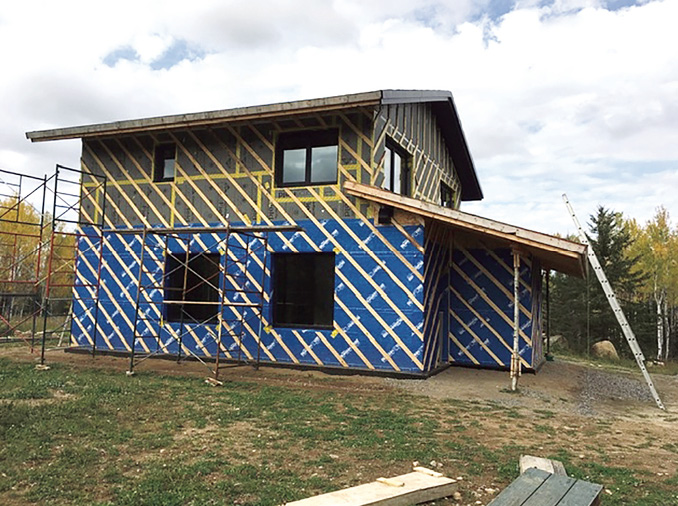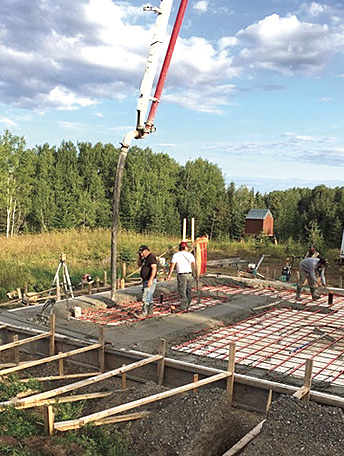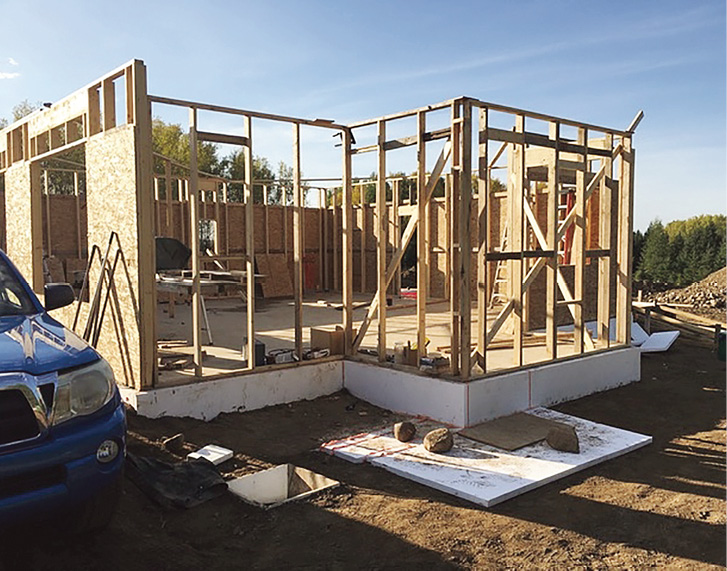A 40-year aspiration to build a high-performance, sustainable house is finally nearing the end for Vic Germaniuk.
Germaniuk, a Thunder Bay woodworker, started constructing his dream high-performance house in the fall of 2022. To take the leap and fund the project, he sold most of his 170-acre property in Kaministiquia, approximately 25 miles northwest of downtown Thunder Bay.
Before the sale, he split off five acres of the property to build his long-awaited 1,700-square-foot two-story vision.
As a woodworker, he has accumulated various building techniques and skills that allowed him to design and build his home with the help of contractors and willing friends. His decision to construct a sustainable, energy-efficient home stemmed from a lifelong passion. “I’ve always been interested in energy efficiency,” he said.
Germaniuk is one of many homeowners in Canada and beyond who, in recent years, have embraced the decision to build a home that prioritizes sustainability and energy efficiency. He said the trend is prevalent in Canada and knows two other Thunder Bay residents currently constructing a net-zero or high-performance home using creative techniques.
High-performance homes or net-zero homes incorporate elements to reduce energy consumption and environmental impact. The homes are meticulously engineered to achieve a balance between the energy they consume and the energy they generate.
Common high-performance home elements include:
- Triple-pane windows and insulated frames
- Optimized orientation of the home to collect, absorb, and distribute solar energy through windows
- Mechanized ventilation systems to improve ventilation and optimize energy usage
- Smart home technology to monitor and control energy use
- High-performance insulation
- Airtight construction to minimize leaks and cold spots
- Energy-efficient appliances
Incorporating these elements into a home can significantly reduce an individual’s environmental impact while increasing energy savings. According to the Canada Energy Regulator, Ontario’s residential sector accounts for 19 percent of energy demand. In the United States, the residential sector accounts for 21 percent of the total U.S. energy consumption.

Since construction began in 2022, Germaniuk has carefully designed and mapped out every aspect of his new home, even going above and beyond Ontario’s building code or recommended insulation R-values in numerous areas.
The recommended R-value for attic insulation in Ontario is between R-50 and R-60. The R-value measures the insulation’s ability to resist heat traveling through it. The higher the number, the better thermal performance.
“I think I’m going to be pressing for close to R-100 in my attic,” Germaniuk said.
He has taken a similar approach to his exterior walls. For southern Ontario, the recommended R-value for exterior walls is R-22 to R-28. “My walls are going to be R-50,” he said, “which is way beyond code as well.”
“So why am I doing this?” Germaniuk said. “I’m doing it because, number one, I think it’s the responsible thing to do as a builder. Number two, I’m hoping that whoever I sell it to down the road, they really appreciate what they’re getting.”
With the above-and-beyond approach, a common concern for homeowners is over-insulating, leading to trapped moisture and decreased air quality. Germaniuk says he has recognized this concern and has considered solutions to counteract it. One of the solutions is to include Innotech tilt-and-turn windows in the home’s design.
The European-style windows, manufactured in Canada, provide optimized energy efficiency and air tightness. “Not only are they well built, but they’ve got really high-efficiency ratings,” Germaniuk said. “They’re a little expensive, but they’re really nice.” The windows have a multi-tilt function to allow the homeowner to easily adjust the tilt to achieve comfortable ventilation in all four seasons.
The second solution Germaniuk will incorporate is a heat recovery ventilator (HRV), a mechanized ventilation system designed to replace stale indoor air with filtered fresh air from the outside. Through a heat exchange process, it captures heat from the outgoing air to preheat the incoming cool air. The process significantly lowers energy costs and improves indoor air quality. “So you need an HRV in the house,” Germaniuk said. “I’m a bit of a freak about energy efficiency.”
Due to the fact that he plans to use an electric boiler for a heating system, he said his home won’t be completely net-zero, but it will be close. Once construction is complete and he can move in, he plans to add solar panels to the roof, further increasing his energy efficiency. “Right now, I’m not getting into that because I just got so much to do,” he said.

While the exterior completion of the home is slated to wrap up this fall, Germaniuk is eagerly waiting to move inside and begin designing his new home’s interior. As a woodworker, he said, “Getting into the interior of the house is my passion. My art.”
“This is what I live for. I’m getting excited about that,” he said. In the midst of building his home, Germaniuk is also designing and building his cabinetry. He said putting up four exterior walls is relatively straightforward and doesn’t allow for creativity or personalization compared to the interior design aspects. “There’s a little more character on the inside.”
Another area for some personalization is the interior and exterior doors. “I’m actually building my doors right now,” Germaniuk said. He is currently building the door jambs, which typically are 5-6 inches. However, given his above-and-beyond wall thickness, “I’ve got 16-inch door jambs. So it’s very, very big, heavy, cumbersome—a lot of labor,” he said. “If you want energy efficiency, you should think about your doors. Doors are very important because you lose a lot of energy.”
Similar to his passion for cabinetry, Germaniuk is thrilled to be crafting his front door. “I approach every door as a blank canvas,” he said. “I like to do something artistic, always on front doors.” His front door will include a design of an eagle inspired by Haida art. Haida are an Indigenous people who live along the coast of British Columbia, Canada, and southeast Alaska and are known for their craftsmanship and mariners. “I’m a huge fan of Haida art,” he said.
Amidst the distinctive charm of his doors and cabinetry, Germaniuk will finish the interior with energy-efficient appliances and LED lighting. “The whole thing, it’s a big package,” he said. “There will not be incandescent light anywhere.”
While plenty of work still lies ahead, Germaniuk remains hopeful that by this fall, he can move into his new 1,700-square-foot energy-efficient home. Since beginning the construction project, Germaniuk said he had learned a lot of valuable lessons about building a house and the difficulties it brings.
From navigating lumber and material costs, construction schedules, and his learning-on-the-job mistakes, it has been challenging. One of the most recent lessons he learned involved using standard OSB sheathing on the first floor of his home and factory-applied permeable grey panels on the second floor. “Big mistake. I should have used the grey panels everywhere. I had to purchase a very expensive blue permeable membrane and then pay a helper to install the product to cover the raw, cheaper OSB panels,” he said. “It’s very important to use a factory-applied panel or an applied membrane that has a high perm rating so it allows moisture to escape through the walls while not allowing air to penetrate the envelope.”
Despite the challenges and lengthy workload ahead, Germaniuk said he looks forward to the first winter storm in his new house.
“It will be 22 below, and I’m toasty warm. I’m playing pool, and outside, it is just storming and blowing. That’s what I’m looking forward to.”






